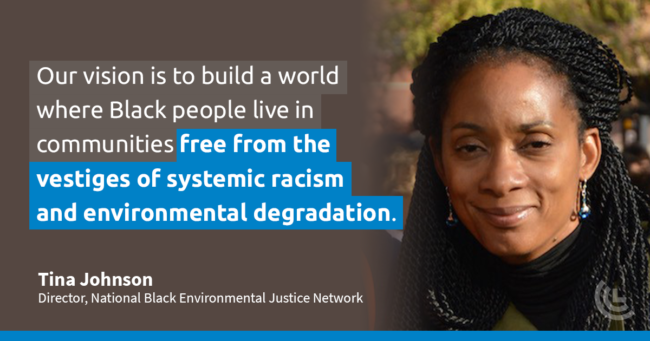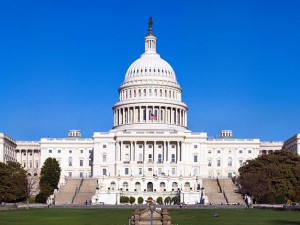Tina Johnson takes on environmental racism
by Elise Koepke
Each month, Citizens’ Climate Lobby hosts an online meeting featuring a guest speaker to educate listeners on topics related to climate change, carbon fee and dividend, and the Energy Innovation and Carbon Dividend Act. Check out recaps of past speakers here.
In the midst of the Covid-19 pandemic, the Black Lives Matter movement has gained sweeping momentum, sparking sustained nationwide protests and a national conversation on systemic racism. An element of that systemic injustice is environmental racism. Tina Johnson, director of the National Black Environmental Justice Network (NBEJN) joined CCL for our September 2020 monthly meeting for a conversation on these topics.
She broke down how the spread of Covid-19 and the eruption of mass protests – which she calls a “double whammy” – has catapulted the NBEJN into recent action. “This assault on Black America has created a crisis that we believe is fueled by racism, economic greed, and reckless disregard for basic civil and human rights,” Johnson explains. In response, NBEJN is working to combat disparities and fight for an end to racially discriminatory environmental decision making.
The NBEJN mission
The NBEJN believes, “Environmental justice affirms the fundamental right to political, economic, cultural, and environmental self-determination of all peoples.” This is the operating definition of the 5th Principle of Environmental Justice as adopted at the 1991 First National People of Color Environmental Leadership Summit.
Johnson identified systemic racism as a primary factor denying Black people access to environmental justice. She remarked on the history of discriminatory processes and policies that have resulted in “polluting industries such as toxic waste facilities, high risk chemical plants, oil refineries, and coal fired power plants turning African American and other poor communities into cancer alleys and environmental sacrifice zones.”
“In short, we want what everyone else wants in the United States and throughout the world,” she explained. The NBEJN advocates for equality through goals of combating environmental racism, expanding their research agenda, and eliminating discriminatory policies at odds with environmental justice. Johnson described her vision of future communities “free from the vestiges of systemic racism and environmental degradation.”
That’s no small feat, so NBEJN employs a strategy focused on four key areas. Through grassroots work, they advance:
1) Safe and healthy communities
2) Sustainable development, climate justice, and clean production
3) Civil rights and equal protection laws and policy
4) International human rights protections
Johnson expressed the importance of working closely with communities that are most on the frontlines of climate change and facing the harshest realities of systemic racism. “We really are focused on the grassroots, but we also reinforce and undergird work with research and analysis that can really look at the problems we’re facing with an equity lens to inform the policies that address health, environmental, economic, and social justice challenges,” she said.
She hopes that through encouraging broader awareness within the Black community and connecting the dots between pollution and poor health, we can restructure historically discriminatory policies and implement new practices that promote an equitable and just society for everyone.
Pollution and racial disparity
“America is segregated, and pollution is also segregated,” Johnson said. “The findings are clear.” She rattled off some startling numbers about the “politics of pollution”:
- Black Americans in 19 states are 79% more likely than their white peers to live near dangerous industrial pollution.
- Historically redlined Black neighborhoods experience temperatures an average of 5 degrees higher than non-redlined areas.
- Black families with incomes of $50-60k live in neighborhoods that are more polluted than where white families with incomes of below $10k live.
Covid-19 has further exposed this racial divide in the United States and shined a national spotlight on healthcare shortfalls and socioeconomic disparities. Johnson explained that these inequities have exacerbated the effects of Covid-19 on Black communities, pointing out how the spread of the virus “closely maps with race, class, place, and environmental disparities.”
She pointed to a Harvard study published in April that found that air pollution is linked to an increased rate of Covid-19 deaths, which can be up to 15% higher in areas with more particulate matter in the air. “Toxic living conditions and environmental racism have helped to inflate death rates among Black people before Covid-19 struck, and now we see that it’s actually had an even more devastating impact,” she said.
Environmental justice and carbon pricing
So how does this all fit in with carbon pricing? Can carbon pricing fit in an environmental justice framework? According to Johnson, it’s possible, but it won’t be simple.
“There’s a lot of work that needs to go into understanding the needs from not just an economic perspective, but a human perspective,” she said, referring to the potential economic and environmental effects of a carbon tax. For Johnson, the answer is “creating something that’s equitable and just, rather than adapting our existing infrastructure to be more equitable and just.”
The solution is nuanced, dependent on the needs of individual communities. “We rarely ever consider the depth of the human cost and human needs – it needs to be balanced,” Johnson said. Once we identify that balance, we can build legislation from there.
To hear more from Tina Johnson, including some Q&A with CCL volunteers, watch the full September meeting on YouTube or listen to the podcast.
Elise Koepke is a communications intern with Citizens’ Climate Lobby. She is a recent graduate of the Georgia Institute of Technology, where she studied Earth Science.






